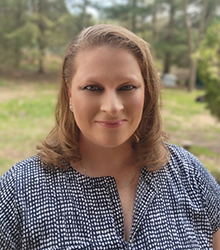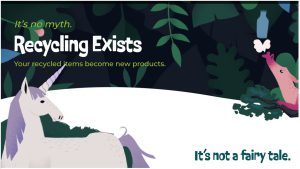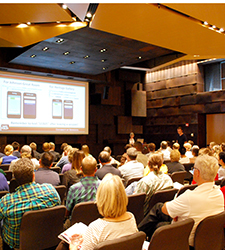May 2024
Inside the Newsletter:
Alaina Ryberg | Recycling | Irrigation | Intern Symposium | Salt Symposium
Alaina Ryberg Celebrates 10 years with MnTAP!
As we prepare to celebrate our 40th anniversary as an organization in October, we will reintroduce the staff that keep this organization going today through a series of interviews. Today we are sharing an interview with our fabulous web and database administrator, Alaina Ryberg, who has been with the organization for a decade! Alaina supports everything from our custom Salesforce instance to our website. She’s been instrumental in the success of our intern program by creating our online intern site on Canvas and developing virtual learning technical topic modules for intern training. In this interview, we threw her a few softball questions and, true to form, she hit them out of the park.
What was your first impression of MnTAP?
I was truly intimidated by how intelligent everyone was. I do not have an engineering background, so sitting in meetings and listening to my coworkers describe their projects was difficult to follow at times. There were so many different acronyms, data, equations, and processes that were all very new to me. Everyone was very nice about explaining things to me and after all of these years I think I may understand a little of what they discuss. I have so much respect for the hard work and dedication that my coworkers have for the projects they are working on.
What has surprised you most about working at MnTAP?
The variety of work and projects that MnTAP is a part of. There never seems to be any one project that is exactly the same. It makes it interesting to see the many different types of industries and organizations that they are able to provide assistance to. Another is the intern program itself. There is so much work that goes on behind the scenes of this program and MnTAP has been one of the leaders in providing this type of opportunity for college students for decades. The program is very dedicated to providing a hands-on learning experience utilizing the knowledge and skills that were learned through their education. While this program is dedicated to giving students hands-on experience, it is also a great opportunity to assist Minnesota organizations in resource conservation.
Can you tell me about someone that influenced your decision to work at MnTAP?
My position at MnTAP is a very unique role within the organization. When I was hired, MnTAP did not have a dedicated position for the website or the database. I was originally hired for a four-month contract role that would be dedicated to restructuring and revamping the health care section of the website. My contract duration continued to be extended as more and more work was available and valued. Soon after multiple extensions, a permanent position was made for my work as the website and database administrator. The person that had the most influence on me and continuing my work with MnTAP was Laura Babcock (Former MnTAP Director). Laura was a great mentor and leader. She provided so many opportunities for me to grow as a professional and was always very encouraging when it came to project ideas.
Can you tell us about one of the projects you worked on in the last year that you are most proud of?
The project that I am the most proud of recently was the development of the Water Assessment Training Module. I proposed, designed, and developed an eLearning training module to be used as part of the intern training program to teach skills used during a water assessment. This is an eLearning site assessment training with a focus on a manufacturing facility’s waste use. The training module was and is used to provide interns with the opportunity to navigate through the module and explore different sections of a facility. The training is a cumulative experience where interns have the opportunity to apply the skills and knowledge that they have acquired throughout previous training exercises from orientation. Through the Water Assessment Training Module, interns are able to gain the knowledge and comprehension of the details required to perform a successful site visit. The module is part of a larger blended training program that includs in-person orientation and training sessions.
Can you tell us one thing about yourself that you enjoy outside of work?
I play on a competitive softball team that travels to play in tournaments all over the US with the majority being in Minnesota.
Does Recycling Work?
Is recycling real? What really happens to those materials when I put them in my recycling bin? Why do these questions even need to be asked in the first place? Unfortunately, these questions are becoming more common, so much so that a website called Recycling Exists was created. This is a local recycling website operated across the seven-county Twin Cities metro area.
According to a report by the OECD, only 9% of plastics produced between 1950 and 2015 were recycled. The US Environmental Protection Agency (EPA) estimates the combined (plastics, cardboard, paper, and glass) recycling rate nationwide as of 2018 was 32%, and that paper and paperboard (67%) and metals (13%) made up the majority of the recycling weight in the United States. Another report by The Recycling Partnership (TRP) did an in-depth analysis of recycling rates at the residential level for each state; Minnesota came in at 20%.
Capital markets (supply and demand) and policies (minimum recycled content in products) both determine recycling rates. First, the economics of transporting materials to a facility, sorting, processing, and cleaning them, and further transporting them to retail stores have to align with the volumes that consumers purchase of those products. If using virgin ingredients in products is cheaper than recycled ingredients, recycled ingredients don’t get processed and used. On the flipside, if not enough supply exists because of lack of recycling engagement (not putting items in bins) with consumers, prices go up for recycled products. Markets are incredibly complex, and these are simple illustrations of what can happen. On the policy side, if minimum recycled content (MCR) percentages aren’t stipulated for various products, businesses may have no reason to process recycled feedstock in their product, as it may be more expensive.
In Minnesota, we are fortunate, as the Minnesota Pollution Control Agency (MPCA) gives estimates of local Twin Cities recycling streams. In 2021, the following materials were recycled:
- Paper, paperboard, and cartons – 525,335 tons – Local paper mills, like WestRock, mix paper and water to form pulp, which is processed into boxboards. Milk and juice cartons go to Sustana Fiber in Wisconsin where they are made into new paper products.
- Metal cans – 193,257 tons – Miller Scrap and Disposal in Winona provides scrap metal to foundries and steel mills across the Midwest. New products include wire, beams, and car and appliance parts.
- Glass bottles and jars – 81,591 tons – Sorted by color at Strategic Materials in Saint Paul. Clear glass goes to Anchor Glass in Shakopee, where it is made into bottles.
- Plastic bottles, containers, and jugs – 33,031 tons – Processed by color and type, plastics are melted into pellets and sold to various companies, including Avon Plastics in Paynesville, where pellets become durable decking, fencing, and landscape products. Drink bottles and produce containers are processed into bottles in Wisconsin and Ohio.
Other counties statewide can visit the SCORE report published by MPCA to understand their recycling rate. Materials may be routed to the various recycling facilities mentioned above. The best way to think about recycling is a hauler picks up recycling, takes it to a Materials Recovery Facility (MRF), and that MRF has contracts in place with various processors to take the material and make new products out of it.
Recycling is a complex topic, and many reports exist, but generally speaking:
- Understand where materials go after they are taken from your recycling bin or centralized location (if recycling is provided in your community).
- Avoid contamination and “wish cycling” by only recycling what the hauler/city/county lists as acceptable items.
- Reduce the number of items you recycle each week by focusing more on reuse (plates, utensils, containers, wrap, and packaging). Do an audit of your own recycling and trash to see what single-use items were disposed of and if reusable options exist. An example would be a Powerade plastic bottle vs. a reusable water bottle.
- Consider purchasing products that have more recycled content (packaging should state percentage).
In conclusion, yes, recycling works! It comes down to putting the correct items in your bin.
Get Ready for Sprinkler Season!
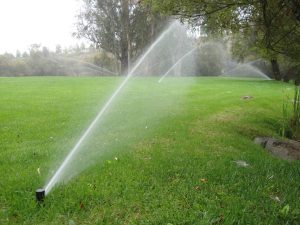 As summer approaches, some facilities may be turning on irrigation systems soon. Irrigation systems often run in the background and receive less attention, but opportunities exist to optimize them. MnTAP projects have reduced irrigation water use for some facilities by 30%. Learn some strategies to save water below!
As summer approaches, some facilities may be turning on irrigation systems soon. Irrigation systems often run in the background and receive less attention, but opportunities exist to optimize them. MnTAP projects have reduced irrigation water use for some facilities by 30%. Learn some strategies to save water below!
As you’re starting up your irrigation system for the season, it’s a good time do some maintenance checks to make sure it is running as efficiently as possible!
- Run each irrigation zone and look for misaligned sprinklers, water spraying where it is not needed (such as on a paved surface), and blocked or broken sprinklers.
- Soggy ground can indicate a leak, which can waste large amounts of water. A single leak at one facility was losing 8 gallons per minute, or over 300,000 gal and $1,500 per month, so it is best to check for leaks regularly.
- If you have a rain sensor or other system components that need a battery, replace the battery at the beginning of each season, or as recommended by the manufacturer. Many only last 1-3 years, and may not be taken care of by your landscape contractor.
- Make sure your system is running at the appropriate pressure recommended by the sprinkler manufacturer, typically 45 psi for rotary sprinklers and 30 psi for spray heads. Pressure that is too low will cause the water to dribble out and not cover the area it is intended to. This could also be another indication of a leak. Pressure that is too high will cause misting which increases evaporation and water being carried away by the wind.
Next, check the irrigation schedule in your control system.
- Lawns generally need a total of about 1” of water per week including rainfall. In Minnesota, we estimate 0.75″ of rain per week so 0.25″ of irrigation is needed. Many systems are programmed to far exceed the needed amount of water, sometimes by 100%! If you don’t know the spray rate of your sprinklers, you can easily measure it by collecting water in cans for 30 minutes or an hour, and dividing the depth by the number of minutes. You can then use the inches per minute to determine how long the system should run each week.
- For optimal lawn health, it is best to water deeply and infrequently. This helps develop healthy, deep roots. Clay soils can be watered just once a week, while sandy soils drain faster and may need to have the total water divided into 2-3 sessions per week.
- The best time to water is early morning (4-8am) to minimize evaporation and wind loss.
- Check the schedule for any errors. A MnTAP intern discovered that one watering zone was duplicated in the system, causing it to use twice as much water as intended. This simple correction was estimated to save over 200,000 gallons and $2,000 per year.
If you’re ready to go beyond maintenance and make some larger changes to reduce your water use, there are several options available.
- Installing a smart controller based on either weather or soil moisture can save an average of 30% of irrigation water by cancelling watering when needs are met through natural rainfall. EPA’s WaterSense program labels controllers that are certified to meet criteria for efficiency and performance.
- Another option is to lower your irrigation needs by replacing turf grass lawns with native and drought-tolerant plants, incorporating hardscaping such as rock or pervious pavers, or creating a rain garden to capture and filter rainwater.
MnTAP has several tools to help evaluate irrigation opportunities. The MnTAP Irrigation Tool outputs how much water should be used for irrigation at a particular facility based on a satellite image of the parcel (only available for the seven metro counties). The Water Assessment Tool outputs the potential water savings based on different watering seasons and schedules that the user inputs. With the Industrial Water Efficiency Optimization Search Tool, you can search for irrigation (or other water uses) and see the recommendations MnTAP interns have made to facilities to save water and reduce costs.
Save the Date! 2024 MnTAP Intern Symposium
The MnTAP Team invites you to attend the 2024 MnTAP Intern Symposium scheduled for Wednesday August 14th, 2024 from 1:00 – 5:00 pm CDT. This event is open to the public and will also be streamed live from the Symposium venue at McNamara Alumni Center at the University of Minnesota. Register now and get this fun, informative event on your calendar!
MnTAP is proud to host 14 interns at companies throughout the state this summer. Projects begin this May for the 2024 MnTAP Intern Program cohort, spanning industries such as food processing, filtration technology, aerospace and more. By the end of August, these interns will have worked closely with their host companies to evaluate opportunities, recommend solutions and as time allows, implement those solutions! The outputs of their work will result in using materials more efficiently, reducing waste, decreasing use of hazardous materials, increasing energy efficiency, and saving water. This will be an inspiring event that you do not want to miss!
RegisterMore info on this summer’s projects will arrive in our July newsletter
2024 Salt Symposium – Livestream – August 6-7, 2024
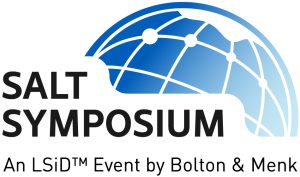 You’re invited to the 25th Annual Salt Symposium! The Salt Symposium celebrates the optimization of salt use to improve community sustainability and protect vital freshwater systems and infrastructure. Free MPCA Smart Salting training included!
You’re invited to the 25th Annual Salt Symposium! The Salt Symposium celebrates the optimization of salt use to improve community sustainability and protect vital freshwater systems and infrastructure. Free MPCA Smart Salting training included!
